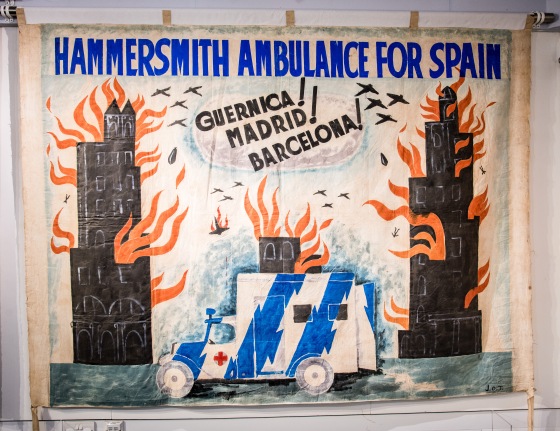Banners for Spain

Nick Wright reviews the current exhibition of banners produced by Hammersmith Communist Party in the 1930s, to help the Spanish Republic.
Legend has it that while Picasso was living in Nazi-occupied Paris during World War II, a visiting German officer asked him, upon seeing a photo of the painting Guernica in his apartment, "Did you do that?" Picasso responded, "No, you did.”
As the veterans of the International Brigades breathe their last, a new generation is recovering the significance of their heroism and of the Spanish tragedy.
Defence of the Spanish Republic was the defining issue of the late Thirties. Britain’s ruling elite favoured accommodation with Nazi Germany and fascist Italy while the democratic Spanish Republic counted on the support of the Soviet Union and enormous international popular movement of solidarity.
In every country this took the the traditional form of political action and demonstration. In Britain there were protests against the government’s so-called ‘non-intervention’ policy which turned a blind eye to Hitler and Mussolini's shameless supply of military aid and mercenaries to Franco’s fascists.
While thousands from every part of the world rallied to the call of the Communist International to form an International Brigade to confront with arms the fascist threat, the solidarity movement everywhere took practical shape.
Banners for Spain, Fighting the Spanish Civil War in London shows in public, for the first time in decades, banners produced by the Hammersmith Communist Party to aid Spain.
These date from 1937-8 and raised awareness of the plight of the Spanish people along with funds and material aid. Some commemorate the International Brigades - two Brigaders from the area died at the battle of Brunete, Labour Party member William H. Langmead and communist Arthur Ernest Richard ‘Dickie’ Bird.
Conservation funding from the Textile Society and the General Federation of Trade Unions means they are able to be displayed and now form part of the Spanish Collection - the largest archive on the British volunteers and aid Spain movement in the country - and donated by the International Brigade Association to the Marx Memorial Library.
All but two of the banners are unattributed but Lawrence Bradshaw (1899-1974) - whose sculpture marks the grave of Karl Marx - was active in Hammersmith and made Hammersmith Communist Party Sends Greetings to Comrades Fighting in Spain which lists the men and women who fell .
Arms and Justice For Spain depicts a worker, a miner with lamp and engineer with spanner shaking hands with a combatant. The slogan ‘No Pasaran’ ‘They Shall Not Pass’ was the universal cry from the defenders of Madrid, and at the Battle of Cable Street.
The banners provide a fascinating insight into the politics of the period and to the uncompromisingly partisan nature of the campaign. Aesthetically, they are a window into the cultural politics of the time and show the wide range of styles deployed by artists of the period, whose commitment to a partisan content infused their work with great creativity.
This is exemplified in the striking banner Hammersmith Ambulance for Spain, with the references to the bombing of Guernica, Madrid and Barcelona. This is signed J.O.T. Julian Otto Trevelyan (1920-1988) was an artist and poet resident in Hammersmith from 1935 until his death who was also a member of the Artists International Association.
In retrospect, the defining work of the period was Picasso’s Guernica. As Morning Star art critic Christine Lindey says: 'Its topical subject and innovatory style provoked strong reactions during its wide exposure first in the Spanish Republic’s pavilion at the Paris World Fair in 1937, followed by touring exhibitions in London, Leeds, Oxford and Manchester in 1938-9 to raise funds for Spanish Relief.'
Questions of style and content enlivened debates among artists. The artists who created these banners worked fast, with little money and with limited materials. We can see a variety of influences at work. This is not surprising given that surrealists and socialist realists clashed over what style was revolutionary and how content could be best expressed, and avant-garde opinion and popular taste widely diverged.
Banners for Spain: Fighting the Spanish Civil War in London is at Islington Museum. 245 St John Street, London EC1V 4NB, to Saturday 8 July 2017. Free.
https://www.islington.gov.uk/libraries-arts-and-heritage/heritage/islington-museum/exhibitions
Christine Lindey’s forthcoming Manifesto Press illustrated book: Art for all, British Socially Committed Art c. 1939 – c. 1962 is due out this autumn.

Nick Wright
Nick Wright is an editor at Manifesto Press, blogs at 21centurymanifesto and is responsible for the Communist Party’s media work.


